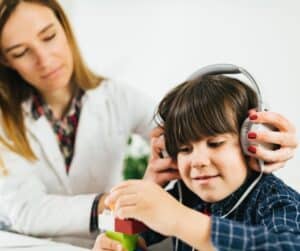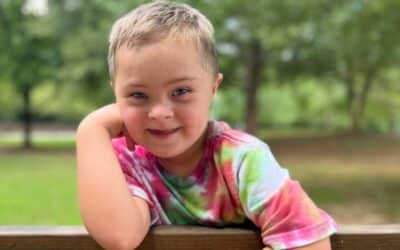Understanding terms related to your child’s speech and language development will help you better support their communication needs, monitor their progress, and advocate for appropriate interventions or resources if necessary. By familiarizing yourself with these thirty words, you’ll be better equipped to support your child’s speech and language development. In this article, we will list and define the top 30 words related to child speech, language, and communication parents need to know:
1. Apraxia
Difficulty planning and sequencing movements needed to produce speech sounds, words, and sentences even though there is no muscle weakness. Example: A child knows what they want to say but struggles to correctly move and sequence the movements of their jaw, lips, and/or tongue to speak the words.
2. Articulation
This refers to the physical ability to move the tongue, lips, jaw, and palate (known as the articulators) to produce speech sounds. Example: If a nine-year-old child says “wabbit” instead of “rabbit,” they may have an articulation problem.

3. Audiologist
A healthcare professional trained to diagnose, manage, and treat hearing problems. Example: A parent might take their child to an audiologist if they suspect hearing loss.
4. Augmentative and Alternative Communication (AAC)
Communication systems, methods, and devices used on a short or long-term basis to supplement or replace oral language. Example: Using sign language, pictures, or communication device to express needs and have a conversation.
5. Bilingualism
The ability to speak and understand two languages. Example: A child may understand and speak Spanish at home and English at school.
6. Code-switching
Switching back and forth between two languages in a single conversation. Example: A bilingual speaker might say, “I love helado and cookies.”
7. Cognitive Communication
Thinking skills that include perception, memory, awareness, reasoning, judgment, intuition, and imagination that influence communication. Example: Remembering a story to tell it later.
8. Developmental Delay
A lag in reaching common developmental milestones in one or more areas of growth, such as speech or motor skills. Example: A 2-year-old child who hasn’t started speaking may be experiencing a developmental delay.
9. Developmental Speech Sound Production Error
Errors in producing speech sounds that are typically expected for children of that age. Example: A three-year-old saying “wabbit” instead of “rabbit” exhibits a developmental speech sound production error because the r sound develops later.
10. Early Intervention
Proactive strategies and treatments that are implemented for individuals at risk for or experiencing speech, language, and communication and/or other developmental challenge. Example: A Speech-Language Pathologist working with a toddler showing signs of language delay. Early Intervention programs offer speech-language therapy and other services to children birth through three-years of age and their families.

11. Echolalia
Repeating noises, words, and/or phrases without obvious understanding or communicative purpose. Example: A child may repeatedly say a line from a TV show without meaningful communication purpose or context.
12. Expressive Language
The ability to put thoughts into words and sentences to convey a message. Example: A toddler saying “I hungry” when they want food.
13. Fluency
The smoothness or flow of speech. Example: Someone who stutters might struggle with fluency.
14. Hearing Impairment
Partial or total inability to hear that can be temporary or permanent. Example: A child may not respond to their name being called due to a hearing impairment related to an ear infection. An audiologist evaluates and treats hearing loss.
15. Intonation
The rise and fall in pitch while speaking, affecting the meaning and emotion of the sentence. Example: The difference in saying “You’re going?” (as a question) and “You’re going.” (as a statement).
16. Language Disorder (Spoken)
A spoken language disorder (SLD) can also be referred to as an oral language disorder. It is characterized by a marked impairment in understanding and using language for a variety of purposes. Spoken language disorder can impact phonology, morphology, syntax, semantics, and pragmatics. These disorders can be present throughout a person’s life, with the symptoms potentially changing over time.
17. Language Milestones
Key developmental stages where children typically achieve specific language skills. Example: By age three, most children use word combinations.
18. Morphology
The structure of words and how they are formed and modified to change meaning. Example: Adding “-ed” to “jump” to form “jumped.”
19. Non-verbal Communication
Communicating without using words, such as through gestures, facial expressions, and body language. Example: A baby pointing to a toy they want.
20. Oral-Motor
Pertaining to the movement and function of the muscles in the mouth (lips, tongue, palate, and jaw). Example: A child might have oral-motor challenges if they struggle with feeding and/or making certain speech sounds.
21. Phonology
This refers to the rules about the sound structure and pattern of sounds in a particular language. Example: A child saying “tup” instead of “cup” might be demonstrating a phonological process error.
22. Pragmatics
The rules for using verbal and non-verbal language in different social situations within a culture. Example: A child understands they should speak differently to a teacher than to a peer.
23. Receptive Language
Understanding or comprehending language. Example: A child understands a command like “pick up the toys.”
24. Resonance
The quality of the voice that is determined by the balance of sound vibration in the oral, nasal, and pharyngeal cavities. Example: Excessively nasal speech can be a result of resonance disorders.
25. Semantics
The meaning of words and word combinations. Example: Knowing that “bark” can refer to a dog making a sound or a tree’s outer layer.
26. Social Communication Skills
How we use language in social contexts. Example: The ability to start a conversation, maintain it, and understand social cues.
27. Speech Sound Disorder
Functional or organic impairment impacting the ability to perceive and/or produce speech sounds correctly, consistently, and fluently. Example: A six-year-old child substituting a consonant sound such as saying “doe” for the word “go.“

28. Speech-Language Pathologist (SLP)
A professional trained to diagnose and treat speech, language, communication, and feeding disorders. Example: If a child is showing delayed understanding and use of language, they will see an SLP for evaluation and intervention.
29. Syntax
Syntax refers to the rules that dictate sentence structure in a language. Example: Understanding the difference between “She is running” and “She are running.”
30. Voice Disorders
A disorder of vocal production impacting an individual’s quality of life. Example: A voice that may be too nasal, too quiet, too breathy, or hoarse.
FAQs
- What’s the difference between speech and language?
- Speech involves the sounds that come out of our mouth and take shape in the form of words. Language is a broader system of understanding and expressing ideas and information using words and non-verbal means.
- When should my child start speaking?
- While each child is unique, most children say their first words between 12-15 months.
- Is it better to speak one language at home if we’re bilingual?
- Research shows that bilingualism can be highly beneficial for cognitive development. It’s good to expose children to both languages early on.
- What can I do to support my child’s speech and language development?
- Encourage communication by responding to and speaking with your child directly and regularly, sharing books, singing songs, emphasizing and repeating important words, exploring together, and engaging in interactive play. If you have concerns about your child’s speech and/or language development, do not hesitate to reach out to a speech-language pathologist.
Additional Resources
- American Speech-Language-Hearing Association (ASHA) ASHA is the professional, scientific, and credentialing association for audiologists, speech-language pathologists, and speech, language, and hearing scientists. It offers a wealth of information on speech and language development and disorders.
- The Hanen Centre: The Hanen Centre is a Canadian not-for-profit charitable organization with a global reach. Its mission is to provide parents, caregivers, early childhood educators, and speech-language pathologists with the knowledge and training they need to help young children develop the best possible language, social, and literacy skills.
- Home Page | NIDCD (nih.gov): NIDCD provides detailed information on a range of issues related to speech, language, and hearing disorders. It’s a reliable source for learning about different disorders, treatments, and ongoing research in the field.
- Zero to Three Description: Zero to Three works to ensure that babies and toddlers benefit from the early connections that are critical to their well-being and development. The site offers a multitude of resources related to early child development, including language and communication skills.
- Living with Down syndrome-ebook.pdf Description: This free downloadable eBook is designed for parents of individuals with a diagnosis of Down syndrome. It offers an inspiring and comprehensive overview of information to support parent understanding and effectiveness. This eBook covers facts related to individuals with a diagnosis of Down syndrome, expectations, mindset, and more.
Summary/Conclusion:
Understanding the terminology related to speech, language, and communication is essential for you as a parent. Familiarity with terms like expressive language, early intervention, and developmental delay helps you in navigating discussions with healthcare providers and advocating for your child’s needs.
Regular interaction, exposure to language-rich environments, and encouraging communication are pivotal in fostering healthy speech and language development in children. For any concerns or inquiries, seeking advice from professionals like Speech-Language Pathologists is recommended.
By being proactive and informed, parents can play a significant role in supporting their children’s speech, language, and communication development, ensuring a solid foundation for learning and interacting in the world around them.




0 Comments